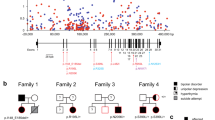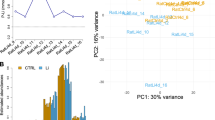Abstract
The pathophysiology of bipolar disorder is still unclear, although family, twin and linkage studies implicate genetic factors1. Here we identified XBP1, a pivotal gene in the endoplasmic reticulum (ER) stress response, as contributing to the genetic risk factor for bipolar disorder. Using DNA microarray analysis of lymphoblastoid cells derived from two pairs of twins discordant with respect to the illness, we found downregulated expression of genes related to ER stress response in both affected twins. A polymorphism (−116C→G) in the promoter region of XBP1, affecting the putative binding site of XBP1, was significantly more common in Japanese patients (odds ratio = 4.6) and overtransmitted to affected offspring in trio samples of the NIMH Bipolar Disorder Genetics Initiative. XBP1-dependent transcription activity of the −116G allele was lower than that of the −116C allele, and in the cells with the G allele, induction of XBP1 expression after ER stress was markedly reduced. Valproate, one of three mood stabilizers, rescued the impaired response by inducing ATF6, the gene upstream of XBP1. These results indicate that the −116C→G polymorphism in XBP1 causes an impairment of its positive feedback system and increases the risk of bipolar disorder.
This is a preview of subscription content, access via your institution
Access options
Subscribe to this journal
Receive 12 print issues and online access
$209.00 per year
only $17.42 per issue
Buy this article
- Purchase on Springer Link
- Instant access to full article PDF
Prices may be subject to local taxes which are calculated during checkout


Similar content being viewed by others
References
Kato, T. Molecular genetics of bipolar disorder. Neurosci. Res. 40, 105–113 (2001).
Goodwin, F.K. & Jamison, K.R. Manic-depressive illness (Oxford University Press, New York, 1990).
Banks, R.E., Aiton, J.F., Cramb, G. & Naylor, G.J. Incorporation of inositol into the phosphoinositides of lymphoblastoid cell lines established from bipolar manic-depressive patients. J. Affect. Disord. 19, 1–8 (1990).
Perez, J. et al. Abnormalities of cAMP-dependent endogenous phosphorylation in platelets from patients with bipolar disorder. Am. J. Psychiatry 152, 1204–1206 (1995).
Yoon, I.S. et al. Altered IMPA2 gene expression and calcium homeostasis in bipolar disorder. Mol. Psychiatry 6, 678–683 (2001).
Bown, C., Wang, J.F., MacQueen, G. & Young, L.T. Increased temporal cortex ER stress proteins in depressed subjects who died by suicide. Neuropsychopharmacology 22, 327–332 (2000).
Chen, B., Wang, J.F. & Young, L.T. Chronic valproate treatment increases expression of endoplasmic reticulum stress proteins in the rat cerebral cortex and hippocampus. Biol. Psychiatry 48, 658–664 (2000).
Wang, J.F., Bown, C.D., Chen, B. & Young, L.T. Identification of mood stabilizer-regulated genes by differential-display PCR. Int. J. Neuropsychopharmacol. 4, 65–74 (2001).
Yoshida, H., Matsui, T., Yamamoto, A., Okada, T. & Mori, K. XBP1 mRNA is induced by ATF6 and spliced by IRE1 in response to ER stress to produce a highly active transcription factor. Cell 107, 881–891 (2001).
Lachman, H.M. et al. Linkage studies suggest a possible locus for bipolar disorder near the velo-cardio-facial syndrome region on chromosome 22. Am. J. Med. Genet. 74, 121–128 (1997).
Kelsoe, J.R. et al. A genome survey indicates a possible susceptibility locus for bipolar disorder on chromosome 22. Proc. Natl. Acad. Sci. USA 98, 585–590 (2001).
Detera-Wadleigh, S.D. et al. A high-density genome scan detects evidence for a bipolar-disorder susceptibility locus on 13q32 and other potential loci on 1q32 and 18p11.2. Proc. Natl. Acad. Sci. USA 96, 5604–5609 (1999).
Ellgaard, L. & Helenius, A. Quality control in the endoplasmic reticulum. Nat. Rev. Mol. Cell Biol. 4, 181–191 (2003).
Yoshida, H. et al. ATF6 activated by proteolysis binds in the presence of NF-Y (CBF) directly to the cis-acting element responsible for the mammalian unfolded protein response. Mol. Cell Biol. 20, 6755–6767 (2000).
Shen, J., Chen, X., Hendershot, L. & Prywes, R. ER stress regulation of ATF6 localization by dissociation of BiP/GRP78 binding and unmasking of Golgi localization signals. Dev. Cell 3, 99–111 (2002).
Kaufman, R.J. Stress signaling from the lumen of the endoplasmic reticulum: coordination of gene transcriptional and translational controls. Genes Dev. 13, 1211–1233 (1999).
Petronis, A. Human morbid genetics revisited: relevance of epigenetics. Trends Genet. 17, 142–146 (2001).
Clauss, I.M., Chu, M., Zhao, J.L. & Glimcher, L.H. The basic domain/leucine zipper protein hXBP-1 preferentially binds to and transactivates CRE-like sequences containing an ACGT core. Nucleic Acids Res. 24, 1855–1864 (1996).
Ikeda, A & Kato, T. Biological predictors of lithium response in bipolar disorder. Psychiatry Clin. Neurosci. 57, 243–250 (2003)
Gray, N.A., Zhou, R., Du, J., Moore, G.J. & Manji, H.K. The use of mood stabilizers as plasticity enhancers in the treatment of neuropsychiatric disorders. J. Clin. Psychiatry 64 Suppl 5, 3–17 (2003).
Kusumi, I. et al. Chronobiological approach for treatment-resistant rapid cycling affective disorders. Biol. Psychiatry 37, 553–559 (1995).
Edenberg, H.J. et al. Initial genomic scan of the NIMH genetics initiative bipolar pedigrees: chromosomes 3, 5, 15, 16, 17, and 22. Am. J. Med. Genet. 74, 238–246 (1997).
Kato, T., Ishiwata, M. & Nagai, T. Mitochondrial calcium response in human transformed lymphoblastoid cells. Life Sci. 71, 581–590 (2002).
Clark, S.J., Harrison, J., Paul, C.L. & Frommer, M. High sensitivity mapping of methylated cytosines. Nucleic Acids Res. 22, 2990–2997 (1994).
Pritchard, J.K., Stephens, M. & Donnelly, P. Inference of population structure using multilocus genotype data. Genetics 155, 945–959 (2000).
Acknowledgements
We thank the individuals with bipolar disorder and unaffected volunteers who participated in this study. Data and biomaterials of the National Institute of Mental Health (NIMH) pedigrees were collected in four projects that participated in the NIMH Bipolar Disorder Genetics Initiative. From 1991 to 1998, the Principal Investigators and Co-Investigators were as follows: Indiana University, Indianapolis, Indiana, USA, J. Nurnberger, M. Miller and E. Bowman; Washington University, St. Louis, Missouri, USA, T. Reich, A. Goate and J. Rice; Johns Hopkins University, Baltimore, Maryland, USA, J. R. DePaulo, Jr., S. Simpson and C. Stine; NIMH Intramural Research Program, Clinical Neurogenetics Branch, Bethesda, Maryland, USA, E. Gershon, D. Kazuba and E. Maxwell.
Author information
Authors and Affiliations
Corresponding author
Ethics declarations
Competing interests
RIKEN, the employer of C.K., K.I., M.I., M.B., T. Kasahara and T. Kato, has a pending patent on the results of this paper.
Supplementary information
Rights and permissions
About this article
Cite this article
Kakiuchi, C., Iwamoto, K., Ishiwata, M. et al. Impaired feedback regulation of XBP1 as a genetic risk factor for bipolar disorder. Nat Genet 35, 171–175 (2003). https://doi.org/10.1038/ng1235
Received:
Accepted:
Published:
Issue Date:
DOI: https://doi.org/10.1038/ng1235
This article is cited by
-
Sustained overexpression of spliced X-box-binding protein-1 in neurons leads to spontaneous seizures and sudden death in mice
Communications Biology (2023)
-
Potential antidepressant-like effects of N-3 polyunsaturated fatty acids through inhibition of endoplasmic reticulum stress
Psychopharmacology (2023)
-
Autism-associated mutation in Hevin/Sparcl1 induces endoplasmic reticulum stress through structural instability
Scientific Reports (2022)
-
Genetic and environmental factors of schizophrenia and autism spectrum disorder: insights from twin studies
Journal of Neural Transmission (2020)
-
ER stress and the unfolded protein response in neurodegeneration
Nature Reviews Neurology (2017)



